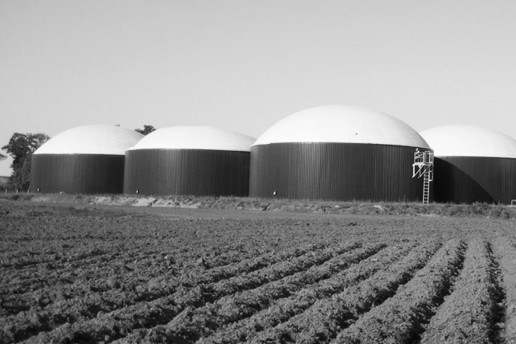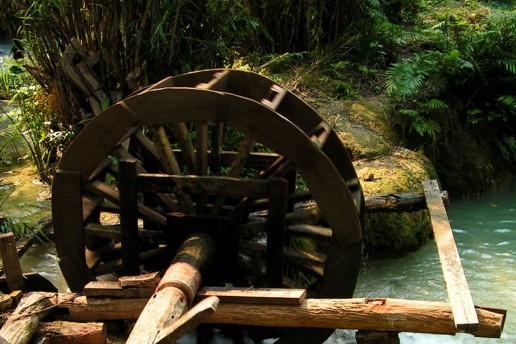The current challenge
Inge Røpke
The analysis of human history from an energy perspective makes it possible to understand the nature of the most fundamental current challenge: Humanity is in the process of finding a new energy base, and we are in the middle of a radical transformation into a fourth phase in our energy history, a new socio-ecological regime. It involves a far more radical change than any that occurred in the development of different versions of capitalism and planned economies. The size of the challenge is illustrated in the figure below, which shows that the world’s energy supply is still predominantly based on fossil fuels. In Denmark, fossil fuels also play a significant role in total energy consumption, although renewable energy sources make a major contribution to electricity production.
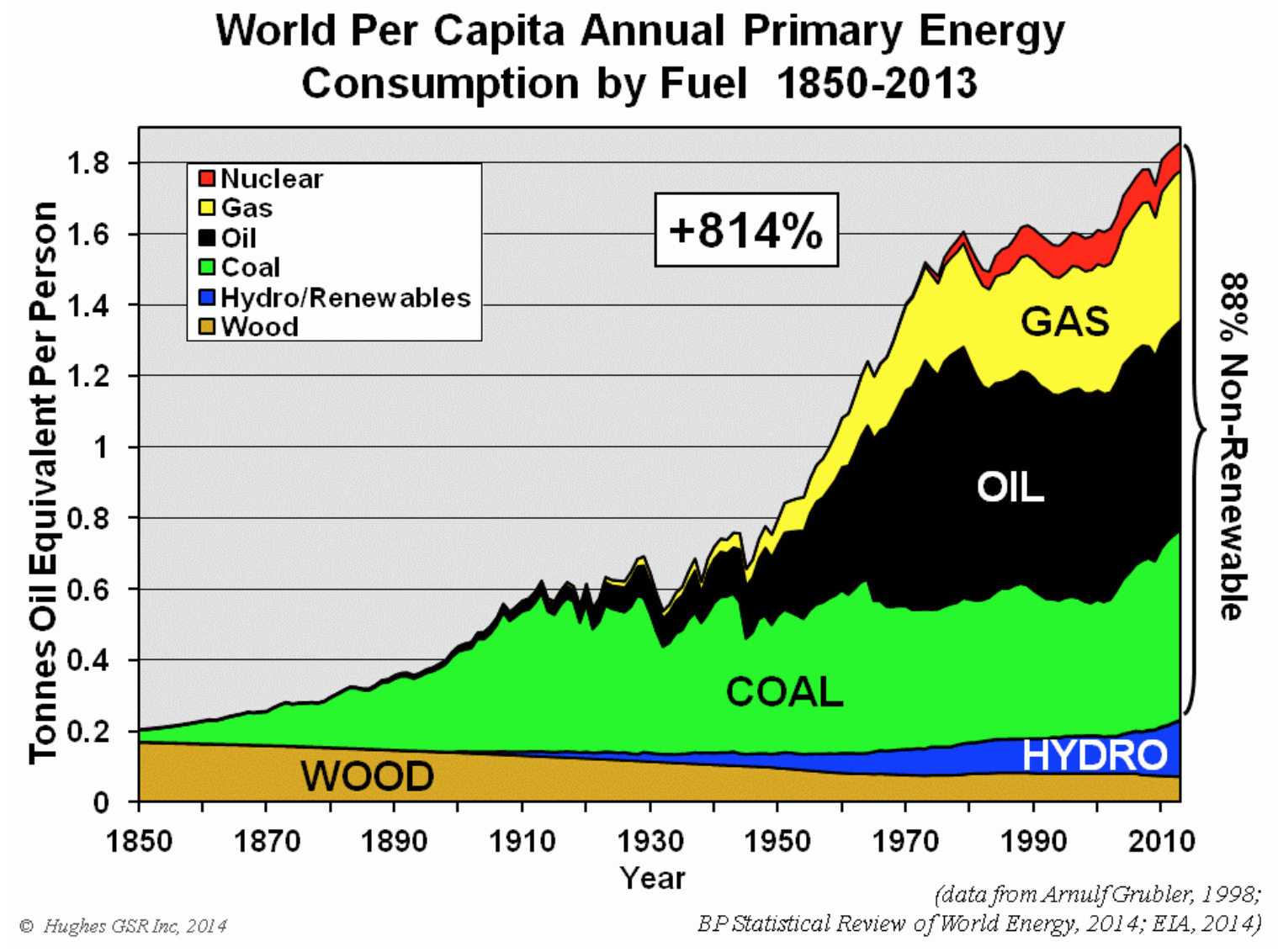
As a result of the use of fossil fuels, humanity has had such an impact on nature that the changes can be measured on a geological scale. Firstly, the emission of carbon into the atmosphere has intensified the greenhouse effect and contributed to a gradual increase in temperatures, acidification of the oceans, an increase in water levels, etc. - and it will do so much more in the future. Secondly, the availability of cheap energy has made it possible to influence the flow of materials so much that it exceeds the previously naturally occurring movements, resulting in significant environmental problems. Thirdly, the growth in population and living standards have led to the appropriation of an increasing amount of land and freshwater for human purposes, which has resulted in a severe decrease in biodiversity. This development has especially been occurring since the end of World War II, which is referred to as ‘the great acceleration’: All curves point upwards.
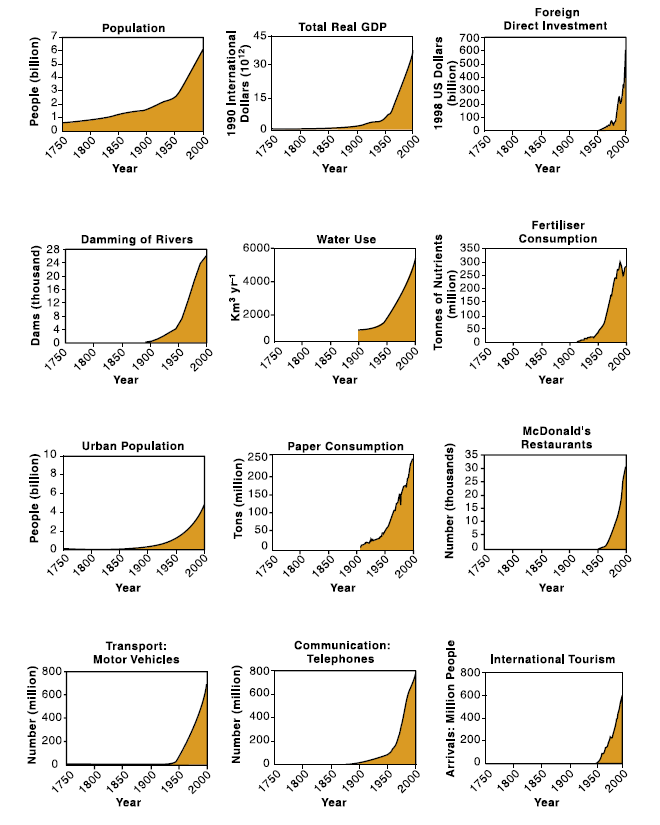
The changes are so significant that geologists are discussing whether we have already moved out of the Holocene and into a new geological epoch that may be called the Anthropocene because of the role human activity has played in the change. Since the conditions in the Holocene epoch have been particularly favourable for humans, there are good reasons to try to avoid the changes heralded by the Anthropocene epoch.
Environmental problems are multifarious and call for different strategies - chemical regulation, the recycling of materials, the reestablishment of ecosystems, etc., but the renewal of the energy base is the most fundamental.
A new energy base
The use of fossil fuels hits a limit into two ways. In the past, there has been a focus on the potential for a lack of fuel. Up to now, this problem has manifested itself by the fact that reserves are becoming increasingly difficult to get hold of because one, of course, starts to extract the most available resources first. Gradually, it takes more and more energy to extract energy, so the net surplus gets smaller. This applies to the extraction of both oil and gas from fields in the sea, the extraction of oil from tar sands, oil and gas from fracking and the extraction of coal from mines where the coal is harder to obtain or is of poorer quality. The concept EROI - Energy Return On (energy) Input – is used to put a figure on this development: During the early phase of oil extraction, which focused on the most easily retrieved oil sources, it was possible to get 100 barrels of oil from using 1 barrel of oil in the extraction process, i.e. EROI was 100. When oil is being extracted from the sea, EROI is often as low as 10. EROI is often measured in relation to the energy input needed for the actual extraction, but energy is also used during the subsequent refining process and transportation to consumers, as well as the more indirect energy consumption connected with the construction of the necessary infrastructure in the form of, for example, roads, cars, petrol stations, car parks, etc. This means that EROI during extraction has to be relatively high to ensure that the society functions.
The other limit is related to carbon emissions. In 2012, the IEA (International Energy Agency) concluded that two-thirds of the known reserves of fossil fuels must remain unused if the increase in temperature is to be kept under 2 degrees. Recent studies have adjusted this figure to three-quarters, but in any case, it seems that not using the reserves is a much bigger challenge than the fact they are scarcer and harder to obtain than previously. Some hope that we can continue to use fossil fuels by using methods to collect the carbon emissions and storing them, such as Carbon Capture and Storage (CCS), but the technology is still at the developmental stage, and the use will exacerbate the problem of decreasing EROI. However, the alternatives to fossil fuels are also associated with problems, while the transition itself is very demanding.
[otw_shortcode_info_box border_type="bordered" border_style="bordered"]Challenges for an energy transition
- Technologies that can exploit renewable energy sources with sufficiently high EROI must be developed.
- Some of the energy sources should preferably (like fossil fuels) have a high energy density, i.e. the amount of energy per weight unit, and be mobile so that they can be used for example in airplanes. In addition, there is a challenge in developing alternatives that can compete with the high energy content per volume of fossil fuels. This is, for example, a challenge for battery technologies, which still can not compete with fossil fuels in this area (see figure: energy density for selected materials).
- Systems where the energy sources support each other must be developed. The systems will be different in different areas, depending on the resources that are available. For example, solar and wind resources are very unevenly distributed.
- Energy needs to be stored because renewable energy sources, such as sun and wind, are erratic.
- Investments in infrastructure that make it possible to exploit energy sources must be made.
- The use of biomass as an energy source must be limited because it competes with land use for food production and the maintenance of biodiversity.
- Solutions must be sought to environmental and social problems that are linked to the alternative sources of energy, e.g. the problems associated with the extraction of minerals for batteries and electronics, or the environmental and safety issues associated with nuclear power.
[/otw_shortcode_info_box]
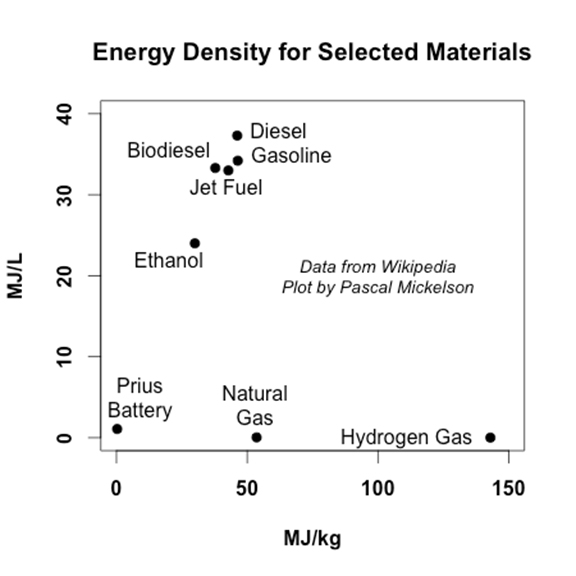
http://www.postcarbon.org/our-renewable-future-essay/
A particular challenge is that the transition itself is energy-intensive. The concept energy cannibalism (originally used in connection with nuclear power) refers to a situation where so much energy is used in the expansion of renewable energy that it surpasses the amount of energy contributed by the renewable energy sources. This, of course, only applies to the period where renewable energy is expanding rapidly, but it makes it difficult to replace fossil fuels sufficiently quickly, especially if you imagine that everyone should also have an even higher standard of living.
The importance of the energy base
Emil Urhammer & Inge Røpke
One of the important differences between ecological economics and mainstream economics is the interpretation of the role of energy in overall production and economic growth. The following extract taken from a book on mainstream economics may help illustrate this difference.
”But the term society cake is more appropriate than most would probably expect. In general, when a baker produces cakes, the same factors are required as when creating GDP.
It requires a large amount of raw materials; typically flour, sugar, cream, butter and cocoa. Employees, such as a baker’s assistant and a shop assistant, are also needed in the store. This is the labour. A dough-mixing machine and, of course, an oven, are also required. The baker also typically has a van to collect and deliver goods. These machines are referred to as the capital stock. But one of the most important factors is the recipe and the process that produces the cake. This is called efficiency or productivity and refers to how fast and efficiently the cake is produced.
If the baker has an excellent computer-controlled mixer and a very good oven, the process will be much faster and easier than if using old and slow procedures, where everything is done by hand and without modern technology. If the baker has a good education and has baked the same cake many times, it can probably also be produced more efficiently and quickly because he has a lot of experience about how to optimise the whole bakery.” (translated from Pedersen & Skovgaard: Økonomisk vækst og velstand i Danmark, Jurist- og Økonomforbundets Forlag 2017, pp. 18-19).
In the above, socioeconomic production is explained by using the example of a baker’s, but the word ‘energy’ is not mentioned at all. This is despite the fact that producing the raw materials, powering the oven and mixing machine and transporting the goods all require energy. Thus energy is involved at all stages of the production process, but this factor is omitted in the narrative. Instead, the quality of the capital stock, the manufacturing process and the baker’s education are highlighted as the important factors of production. This is not wrong, but without energy it is not possible.
 Illustration: Sonja Winckelmann Thomsen.
Illustration: Sonja Winckelmann Thomsen.
When mainstream economists explain what results in growth, they emphasise labour, capital and technological development. Technological development is presented as if the only important factor is having a good idea. However, a good idea is nothing in itself because it depends on energy - in most cases fossil fuels. This has been forgotten in mainstream theory about economic growth, whereas it is emphasised as being central in ecological economics. Thus an important element in ecological economics is emphasising that technological innovation and energy are inextricably linked. Technological innovation, which mainstream economists emphasise as being crucial for economic growth, is completely ineffective without energy. Without fossil fuels, the industrialisation and massive growth in the industrialised world since World War II would not have taken place. Therefore, we face major challenges in the future because climate change demands that we find a new, renewable energy base.
[otw_shortcode_info_box border_type="bordered" border_style="bordered"]Thermodynamics and energy quality
In the field of ecological economics, the discipline of thermodynamics plays an important role. This is due to the fact that thermodynamics provides an understanding of the concept of energy and the benefit people can have from different energy sources. Thermodynamics encompasses a number of laws, but in the following, we only mention the first and the second, which are particularly important for ecological economics.
1.The first law of thermodynamics states that: Energy can neither be created nor destroyed; it just changes form.
If we take petrol that is burned in a car engine as an example; according to the first law, there is no creation and no energy is lost in this process. What happens is that the chemical energy in the petrol is transformed into mechanical energy: the pistons move up and down, the drive shaft rotates, the wheels rotate, and the car moves forward. All this mechanical energy ultimately becomes heat - molecular mechanical energy. In short, the chemical energy has not disappeared; it has just become heat (molecular motion).
2.The second law of thermodynamics states that: Every time energy changes into a new form, an ‘energy loss’ occurs.
However, ‘energy loss’ does not mean that the lost energy has disappeared, it just means that it has turned into a less useful form. Let’s continue with the example above. A certain amount of chemical energy is used to move the car from A to B. One can now say that the energy has performed a useful job, but during the process, all the chemical energy in the fuel has become heat. This heat consists of molecular motion in the surroundings, which is very difficult to exploit for a useful purpose. Energy has, therefore, performed a useful task, but a ‘loss’ has occurred during the process.
According to the two ecological economists, Herman Daly and Joshua Farley, the reason why these two laws are important for the economy is that the first law tells us that there is a limited amount of energy available, while the other law tells us that there is also a limit to how many times we can use the available energy. Each time we use energy, it transforms into a form that is difficult to exploit.
In this context, the concept of ‘energy quality’ is important. Energy quality refers to the potential of energy to perform useful work. The easier it is to convert energy into useful work, the higher the energy quality. The waste heat from a petrol engine contains a sizeable amount of energy, but it is difficult to use for practical purposes. The chemical energy in fossil fuel, on the other hand, is relatively easy to convert into useful work. Therefore, one can say that the waste heat is of low energy quality, while fossil fuels are of high energy quality.[/otw_shortcode_info_box]
Energy and population
Another very important aspect of energy and the energy base is the role of energy in population growth. Vaclav Smil, who has worked extensively with the connections between energy, the environment and the population, emphasises that the unprecedented population growth which has taken place in the last 80 years, simply could not have taken place without fossil fuels. This is because energy is indispensable for fundamental survival factors such as food, shelter and work. Industrialised agriculture provided the growing population with the necessary food; urban development provided the necessary housing, and industrialisation created jobs for more and more people - all driven by fossil fuels.
With regards to food production, it is important to stress that fossil fuels are indispensable for modern industrialised agriculture, which uses them to power agricultural machinery, for fertilisers, pesticides (weed control and pest control) and transport. Therefore, we are currently facing a twofold challenge: On the one hand, we need to switch our energy consumption from fossil fuels to renewable energy sources, while on the other hand, the global population is increasing, which makes this challenge particularly difficult. This means that one of the great challenges in the future will be to find out how to feed a growing population without fossil fuels. One of the obvious answers is to try to stabilise the global population at a sustainable level. In many countries, a decrease in the size of the population is considered to be a problem. If the decrease is due to major social problems, widespread alcoholism or genetic damage caused by chemicals, there are of course good reasons to address these problems. However, falling population is not a problem in itself, but rather, it should be seen as a contribution to a sustainable transition. The decrease may give rise to transition problems as a result of changes in the age composition of the population, but it is better to find solutions to such problems than to increase the risk of destroying our own basis for life.
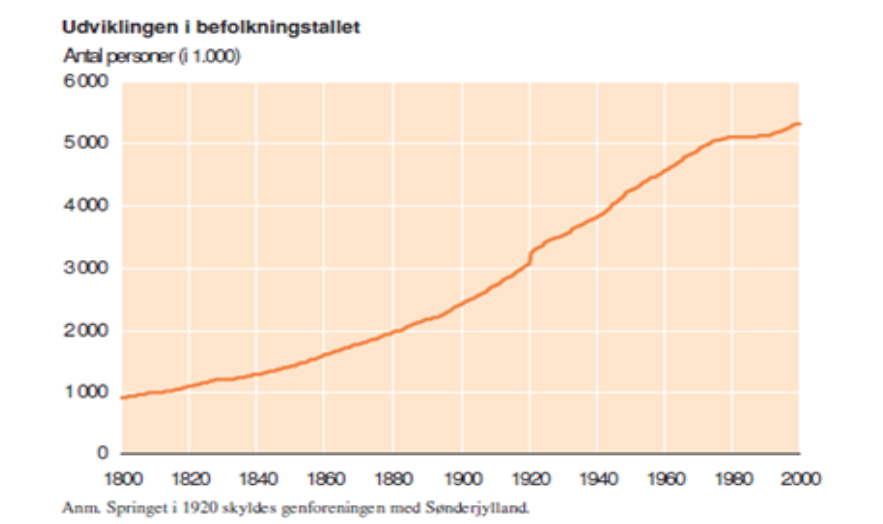
Humanity’s energy history
Inge Røpke
In this section, we look at how people have gradually learned to utilise a greater number of energy sources, which has been an important factor in the establishment of the highly developed society we have today. But before we begin to discuss this energy story, we must first introduce some basic concepts and a few useful terms.
Several conditions must be met in order for humans to survive. For example, a sufficient amount of oxygen in the atmosphere, the availability of fresh water and, not least, access to energy, which is consumed in the form of food. The energy content of food comes from photosynthesis in plants, which involves converting solar radiation into chemical energy, which is stored in the biomass of plants.
People can consume this energy directly by eating plants or indirectly by eating herbivorous or carnivorous animals, all of which ultimately get their energy from the photosynthesis of plants. This is called the food chain. When an organism dies, bacteria and other organisms break it down so its biological components once again become part of the food chain. This cycle does not necessarily imply that all the biomass is recycled. For example, fossil fuel energy reserves have been formed because biomass from plants and animals has been stored underground for many millions of years. When humans started to mine for this stored biomass, you could say that they gained access to a very large store of solar energy (chemical energy resulting from photosynthesis) in a very convenient and easily usable form.
Because of the key importance of energy, it is important to examine how humans have used it over time. For this purpose, the concepts endosomatic and exosomatic energy consumption, which were introduced by the biologist, Alfred Lotka, in the early 20th century, are useful. Endosomatic energy consumption consists of the energy that one species absorbs through food and transforms into growth, movement and heat. All species have an endosomatic energy consumption, whereas until now, only humans have been able to exploit energy exosomatically. Exosomatic energy consumption refers to the use of energy for processes outside the body. The first time that humans were able to consume energy exosomatically was when they learned how to control fire. However, today, humans exploit a very large amount of energy exosomatically for innumerable activities and purposes such as transport, heating and street lighting.
Another useful concept for the story that follows is Human Energy Equivalent (HEE), which is used to denote the amount of endosomatic energy needed to keep a human being alive. The amount varies between individuals and between different climatic regions, but the two ecological economists, Michael Common and Sigrid Stagl, estimate that 10 megajoules per day is a good estimate of the average HEE.
The agricultural society
About 12,000 years ago, at the end of the last ice age, the climate warmed significantly and stabilised. During the geological period that followed, called the Holocene, conditions for humans became particularly favourable. The fluctuations in temperature became much smaller than they had been in the Pleistocene, which facilitated the establishment of long-term settlements and agriculture.
In contrast to the hunter-gatherer societies, agricultural societies were characterised by specialisation and hierarchy, while the organisation of the agricultural operations made it possible to obtain a significantly larger amount of biomass from a given area. Agricultural societies secured more energy by converting biomass to pulling power from animals and by using water and wind power. The energy consumption of agricultural societies is estimated at 3-4 HEE per person.
One might think that the increased energy surplus would improve living conditions, but for most, it was actually the reverse. Specialisation involved hard work and a short life for many, while the social surplus was used to construct magnificent structures, provide culture for the few and to wage war. In the transition from hunter-gatherer societies to agricultural societies, the latter were clearly the strongest, but hunter-gatherer societies survived in isolated pockets in some areas, and some even still exist today.
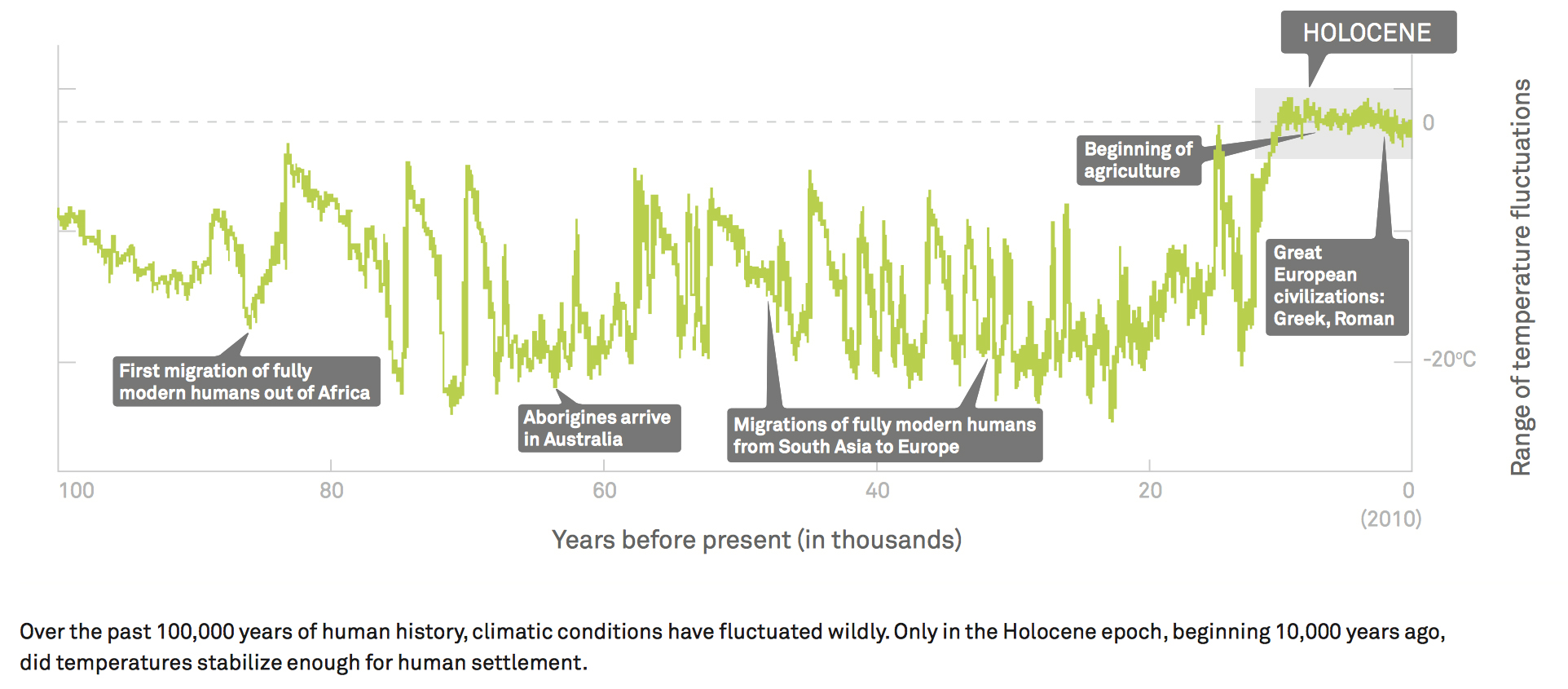
Agricultural operations involved significant changes to ecosystems as large areas were cleared of vegetation other than the intended crop. In some cases, farming communities gradually undermined their own livelihoods because the cultivation methods and the use of wood as raw material and fuel led to deforestation, salinisation and soil erosion, and because they did not find ways of solving these problems in time.
Industrial society (from around 1800)
The transition to the industrial society was, among other things, due to increasing resource problems in the agricultural society. In England, the use of timber had led to deforestation and a lack of wood as an energy source. For a long time, people had been aware of the potential of using coal, but it was only when a lack of wood became apparent that demand for coal increased. This stimulated technological development because the excavation of coal in deep mines required pumps to keep the water out and the operation of pumps stimulated the development of the steam engine, which required iron. The production of which demanded more coal. This spiral in technological development gradually led to coal becoming the primary source of energy in conjunction with key technologies related to the production of iron and the use of the steam engine.
With the discovery of oil and gas, industrialisation became linked to the internal combustion engine and then to the electric motor with the introduction of electrification. The use of fossil fuels combined with mechanisation and subsequently automation resulted in a significant increase in labour productivity. According to Common and Stagl, the average global exosomatic energy consumption in 1900 was approximately 14 HEE per person, which is as if every individual had 14 ‘energy slaves’ at their disposal. Since then, this figure has risen further and it is estimated that in 2000, on average, each human being had 19 ‘energy slaves’ at their disposal. However, this average was very unevenly distributed because, according to Common and Stagl, an American had about 93 ‘energy slaves’, while someone living in Bangladesh only had about 4 ‘energy slaves’ at their disposal.
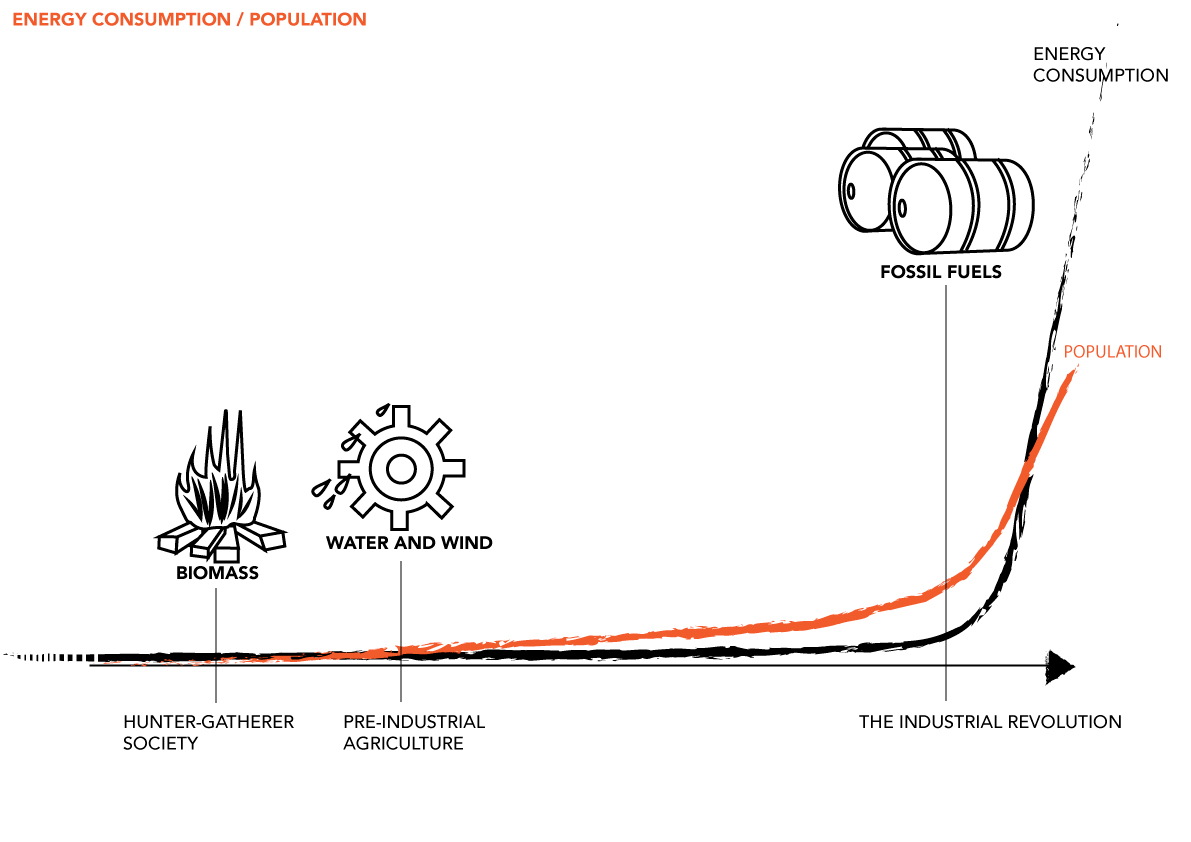
Initially, it was primarily the manufacture of craft products that was mechanised, but later agricultural production also became industrialised. Human labour and horses were replaced by machines, and fossil fuels formed the basis for the production of fertilisers and pesticides to control weeds and pests. In combination with increasing meat production, mechanisation has resulted in agriculture now being a net consumer of energy, i.e. the amount of energy in the food that has been produced is less than the amount of energy used to produce it. This is in contrast to pre-industrial agriculture, where the yield expressed in energy was much greater than the energy used in the form of labour and draught animals. This surplus was due to photosynthesis, which is based on a generous gift in the form of solar energy. Even though modern agriculture also receives this gift, there is still no energy surplus. The advantage primarily lies in the significant increase in labour productivity, which is achieved by replacing labour with machines and fossil energy, while area productivity can often also be increased. In a way, one can say that today we are eating fossil fuels.
Next: The importance of the energy base
Introduction: The energy basis
Energy combined with humanity’s ability to exploit its different forms is an important key to understanding the economic development of society. Since the beginning of humanity, we have learned to utilise an increasing number of energy sources for an increasing number of purposes. This development has been instrumental in the success of human beings and the emergence of our high-tech civilisation. In this theme, we will look more closely at the role of energy in the development of human beings from hunter-gatherer cultures to modern industrialised societies. Fossil fuels are an important factor in this story, firstly because they made industrialisation possible, and secondly that the burning of these fuels is the main cause of climate change, which is currently in full swing. Therefore, this theme also focuses on the challenge that is currently facing humanity; making the transition to a new, renewable energy basis.
Next: Humanity's energy history
